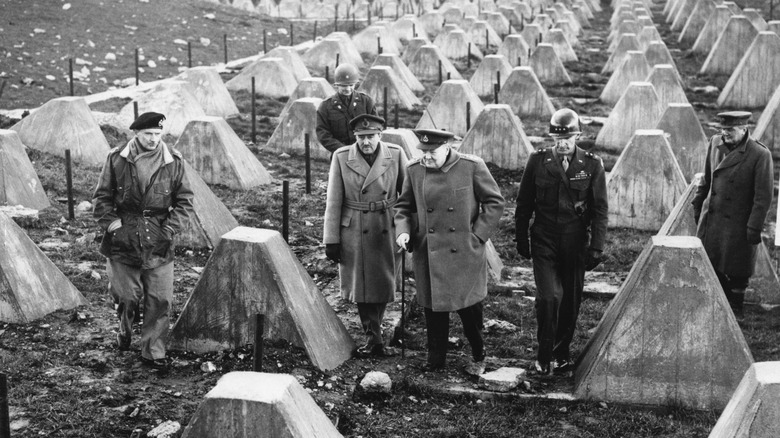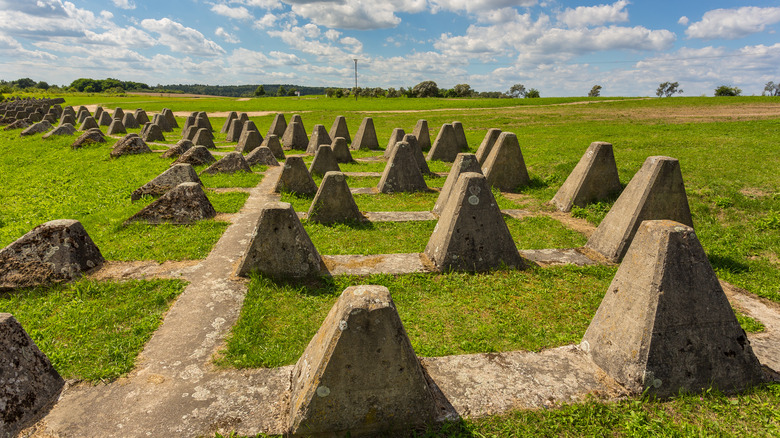WW2 Dragons Teeth: The WW2 Tank Traps You Can Still See Today
In patchy spots near Aachen, Germany, rows of concrete pyramids make a zig-zag pattern that is as beautiful and symmetrical when viewed from the air, as it is haunting or menacing looking at down on the ground. During World War II, these strategic tracked vehicle obstacles, aptly named "Drachenzähne" or "Dragon's teeth," formed anti-tank barriers stretching 390 miles along the German borders with Belgium and the Netherlands. Standing around three to four feet high and arranged in staggered rows, tanks couldn't go over them, nor could they maneuver through. Their flat tops and deeply embedded roots made them impassable obstacles.
Tank traps like these slow down or divert tanks, making them vulnerable to attack. Surrounding these barriers were additional hazards like landmines, barbed wire, and trenches, further restricting movement for both armored vehicles and foot soldiers. Dragon's teeth were crucial in hindering tank advancements and bolstering defensive strategies during the war.
Remnants of War
After the war, destroying or removing the teeth was too costly, so they were left to blend into their surroundings. The teeth have acquired the patina of their environment; whether covered in moss and mold or bleached white by the sun, they remain mostly unchanged from the day they were made. Farmers use these areas for grazing. Communities cleared the brush to create historic sites with walking paths, making them a destination for military buffs. Immersive guided tours specializing in WWII battlefield experiences across places like Normandy, Hollerath, and the Ardennes offer insightful perspectives on the historical importance of these sites.
Dragon's teeth are also along Britain's coast, designed to defend against amphibious tank landings from the North Sea and the English Channel. Many are still visible at Fairbourne Beach, Wales, the Isle of Grain in North Kent, along the River Wey in Guildford, Surrey, and Cramond, Edinburgh, Scotland. Though never tested in battle, the teeth serve as poignant reminders of a time when the shores of Great Britain stood on the brink of uncertainty. In the rugged terrain of Northern Italy and the peaks of the Alpine Wall are uniquely shaped Dragon's teeth, which resemble concrete blocks crowned with a Hershey Kiss. Venture further into Wimmis in the Canton of Bern, Switzerland, where these inert remnants dot the landscape.
Reviving Dragon's teeth
Dragon's teeth are not a thing of the past. The anti-tank obstacles are still used in military strategy today, as seen in the video above. Despite originating in World War II, Dragon's teeth remains pertinent in today's military strategy.
In areas marked by ongoing geopolitical tensions, like the border between Russia and Ukraine, Poland's frontier with Kaliningrad, and the Baltic borders of Lithuania, Latvia, and Estonia, Dragon's teeth are being reintroduced as defensive measures to deter potential threats. In April 2023, Reuters reported that satellite imagery taken by Capella Space showed barriers stretching from western Russia through eastern Ukraine toward Crimea. Both Ukraine and Russia aim to thwart each nation's plans for tank invasions. Recent reports from the London Times suggest ambitious plans for NATO nations to fortify roughly 1,000 miles of the Baltic borders with these recognizable defensive structures. As tensions linger in these regions, the deployment of Dragon's teeth symbolizes strategic readiness and a deterrent to potential adversaries, echoing their historical significance in past conflicts.
Know before you go
If you plan to explore these locations independently, proceeding with caution is crucial. Pay attention to warning signs, especially on private property. Remember that Dragon's teeth are over 80 years old and have endured decades of weathering and decay. Avoid climbing on them or allowing children to do so, as they may be unstable. Since cell service can be unreliable in remote areas, it's wise to carry a local map for navigation.
Some of the Dragon's teeth may be hidden within forests, with limited signage to guide you. Luckily, locals may have some advice, and there are tours. Their deep-rooted connections to the land and its history can help you explore these hidden treasures. For truly captivating photographs, consider venturing out in the early morning when the landscape is draped in mist and fog. This atmosphere can add an eerie quality to your images, enhancing the haunting beauty of these historic sites.


